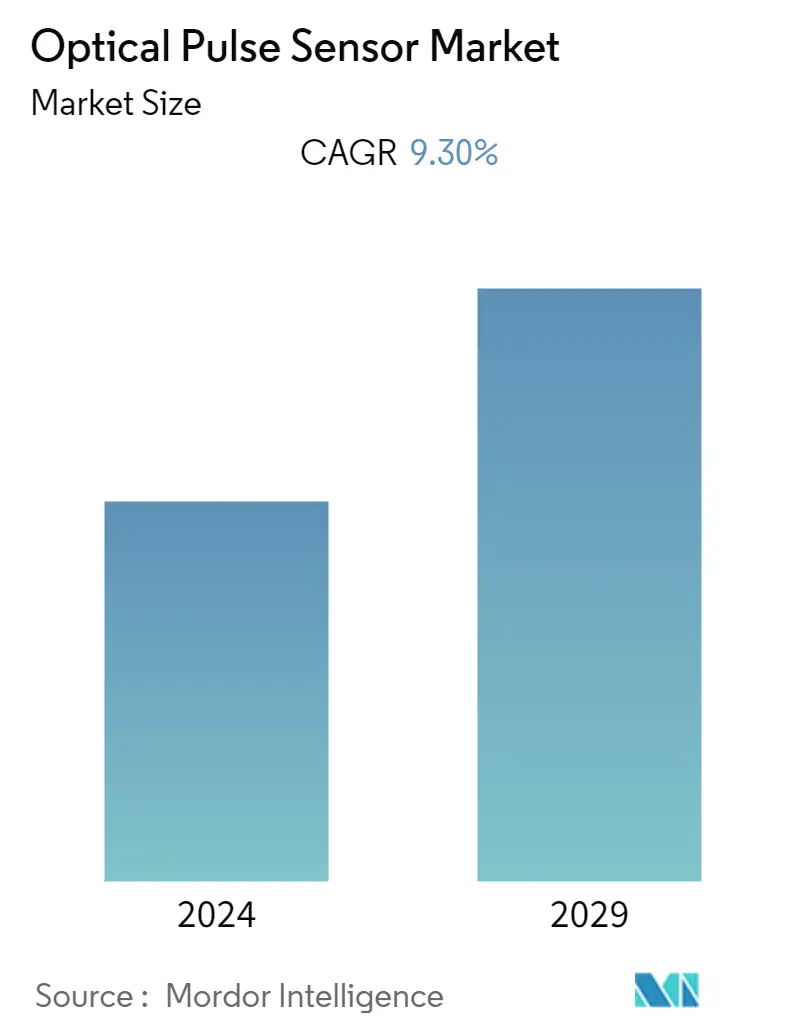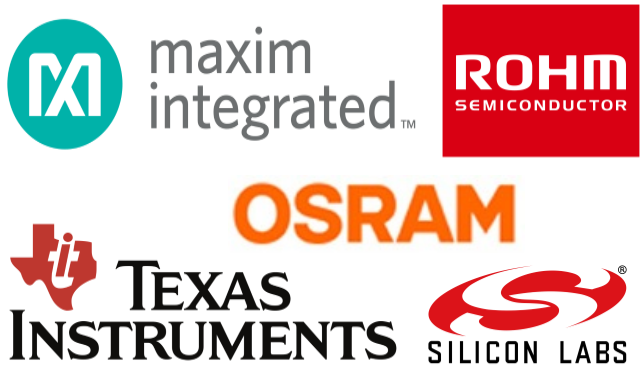Market Size of Optical Pulse Sensor Industry

| Study Period | 2019 - 2029 |
| Base Year For Estimation | 2023 |
| CAGR | 9.30 % |
| Fastest Growing Market | Asia Pacific |
| Largest Market | North America |
| Market Concentration | Medium |
Major Players
*Disclaimer: Major Players sorted in no particular order |
Optical Pulse Sensor Market Analysis
The optical pulse sensor market is expected to witness a CAGR of 9.3%, over the forecast period (2021 - 2026). The capability of the sensors to improve accuracy and increase functionality and efficiency of several applications, along with the growth in the use of wearable, may generate significant demand for optical pulse sensors.
- The rise in the use of diagnostic wearable medical devices for regular personal health monitoring is expected to drive the optical pulse sensor market.
- Advancements in some diagnostic wearable medical devices led to an increased number of individuals to use these devices. The integration of IT in most diagnostic wearable medical devices is on the rise, and the automated generation of medical records in digital format [electronic health record (EHR)] has driven the demand for advanced devices.
- Wearable devices and analytical software revolutionized sports and fitness training, by engaging in performance improvement and injury prevention. Companies in the market are implementing strategic initiatives to meet the rising demand in the market.
Optical Pulse Sensor Industry Segmentation
Optical sensors are devices that convert light or infrared rays into electronic signals. They can function in the presence of light or infrared spectrum, and form a part of a huge electronic system. The recent progress in optical technology allows easy integration of these sensors into various systems, with improved performance for new functions in new domains using innovative technologies.
| By Application | |
| Smart watch | |
| Smart Bands | |
| Smartphones | |
| Other Applications |
| Geography | ||||||
| ||||||
| ||||||
| ||||||
| ||||||
|
Optical Pulse Sensor Market Size Summary
The optical pulse sensor market is poised for significant growth, driven by the increasing adoption of wearable devices that enhance accuracy and functionality across various applications. The integration of IT in diagnostic wearable medical devices, coupled with the automated generation of electronic health records, is propelling demand for these advanced sensors. Wearable technology, particularly in sports and fitness, is transforming performance improvement and injury prevention, prompting companies to adopt strategic initiatives to capitalize on this growing market. Smart bands, equipped with miniaturized electronic devices, are becoming mainstream for monitoring fitness, heart rate, and other health metrics, with manufacturers focusing on advanced actuators and sensors to enhance user interaction and energy efficiency.
The market is further fueled by the rising prevalence of chronic diseases and the need for continuous health monitoring, which is driving the demand for diagnostic wearable medical devices. The launch of new products and technological advancements, along with regulatory approvals, are key factors contributing to market expansion. The optical pulse sensor market is moderately competitive, with major players dominating the landscape. However, technological innovations in the wearables segment are enabling companies to expand their market presence through new contracts and market exploration. Notable developments include projects by Osram Opto Semiconductors and Texas Instruments, which are advancing the capabilities of optical pulse sensors and related technologies.
Optical Pulse Sensor Market Size - Table of Contents
-
1. MARKET DYNAMICS
-
1.1 Market Overview
-
1.2 Introduction to Market Drivers and Restraints
-
1.3 Market Drivers
-
1.3.1 Rising Adoption of Wearable Devices across Multiple End-user Segment
-
1.3.2 Increased Health and Fitness Awareness
-
-
1.4 Market Restraints
-
1.4.1 Technical Issues due to Sensor Location on the Body
-
-
1.5 Industry Value Chain Analysis
-
1.6 Industry Attractiveness - Porter's Five Forces Analysis
-
1.6.1 Threat of New Entrants
-
1.6.2 Bargaining Power of Buyers/Consumers
-
1.6.3 Bargaining Power of Suppliers
-
1.6.4 Threat of Substitute Products
-
1.6.5 Intensity of Competitive Rivalry
-
-
-
2. MARKET SEGMENTATION
-
2.1 By Application
-
2.1.1 Smart watch
-
2.1.2 Smart Bands
-
2.1.3 Smartphones
-
2.1.4 Other Applications
-
-
2.2 Geography
-
2.2.1 North America
-
2.2.1.1 United States
-
2.2.1.2 Canada
-
-
2.2.2 Europe
-
2.2.2.1 United Kingdom
-
2.2.2.2 Germany
-
2.2.2.3 France
-
2.2.2.4 Rest of Europe
-
-
2.2.3 Asia-Pacific
-
2.2.3.1 China
-
2.2.3.2 India
-
2.2.3.3 Japan
-
2.2.3.4 Rest of Asia-Pacific
-
-
2.2.4 Latin America
-
2.2.4.1 Brazil
-
2.2.4.2 Argentina
-
2.2.4.3 Mexico
-
2.2.4.4 Rest of Latin America
-
-
2.2.5 Middle East & Africa
-
2.2.5.1 United Arab Emirates
-
2.2.5.2 Saudi Arabia
-
2.2.5.3 South Africa
-
2.2.5.4 Rest of Middle East & Africa
-
-
-
Optical Pulse Sensor Market Size FAQs
What is the current Optical Pulse Sensor Market size?
The Optical Pulse Sensor Market is projected to register a CAGR of 9.30% during the forecast period (2024-2029)
Who are the key players in Optical Pulse Sensor Market?
Maxim Integrated Products Inc., Osram Licht AG, ROHM Co. Ltd, Texas Instruments Inc. and Silicon Laboratories Inc. are the major companies operating in the Optical Pulse Sensor Market.

